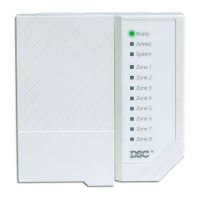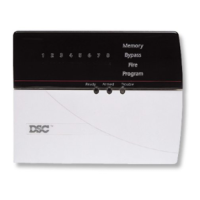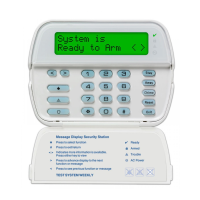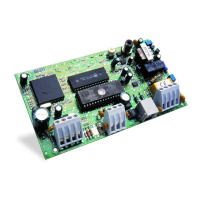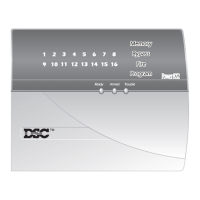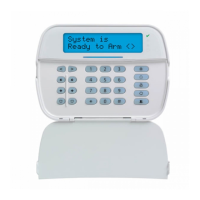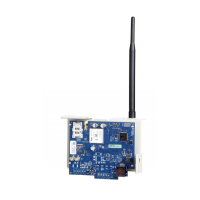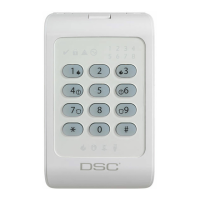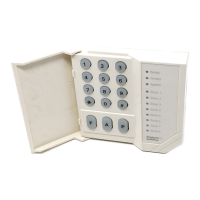Program Descriptions: 5.10 Communicator – Reporting Formats
19
AC Failure Trouble Alarm Code
To prevent the panel from transmitting an AC Failure Trouble
Alarm reporting code during short power outages, the panel
will not send the signal unless AC power is lost for the amount
of minutes programmed for the AC Failure Communication
Delay. The AC Failure Trouble Restoral reporting code follows
the AC failure communication delay as well.
NOTE:If AC Failure Communications Delay is programmed as
“000,” then the AC failure transmission will be immediate.
AC Failure Communication Delay . . . . . . . . . . Section [370]
Wireless Maintenance
The panel will transmit a Wireless Device Low Battery Alarm
reporting code if a low battery condition is indicated by a
detector. The transmission of the trouble will be delayed by
the number of days programmed for Zone Low Battery
Transmission Delay. The Wireless Device Low Battery Resto-
ral reporting code will be transmitted when the problem is cor-
rected. The specific zone that caused the trouble will be
recorded in the event buffer.
NOTE: The restoral will not be transmitted until all detectors
indicate good battery conditions.
Wireless Maintenance Reporting Codes . . . . . Section [353]
Wireless Device Battery Transmission Delay . . Section [370]
Arming and Activity Delinquency
When Delinquency Follows Arming (Days) is selected, the
Delinquency reporting code is sent whenever the panel is not
armed within the number of days programmed for the Delin-
quency Transmission Cycle.
NOTE: If the Delinquency Transmission Cycle is set for one
day, there must be 24-hrs of no arming or disarming before the
Delinquency Code will be sent. After a Delinquency Code has
been transmitted, it will not be sent again until the system has
been armed and disarmed.
When Delinquency Follows Zone Activity (hours) is
enabled, if there is no activity on zones in the system, the
Delinquency Transmission Cycle Timer in Section [370] will
begin counting in hours. When the counter reaches the pro-
grammed time, the panel will communicate the Delinquency
reporting code to the central station, if programmed. If there
is a closing or zone activity present on the system at any time,
the counter will be reset.
NOTE:Activity Delinquency will not be reported while the panel
is armed in Away mode.
NOTE:Activity on manually bypassed zones will not reset the
timer.
NOTE:This timer is reset when the panel is armed, or if
Installer Programming is entered.
NOTE:When using the SIA FSK communication format with
Activity Delinquency, the Closing Delinquency identifier is
transmitted.
Miscellaneous Maintenance Reporting Codes Section [351]
Delinquency Follows Zone Activity. . . . . . . . . . . . . . [380]: [8]
Delinquency Transmission Cycle . . . . . . . . . . . . . . . . . [370]
5.10 Communicator – Reporting Formats
Each communication telephone number can be programmed
to report using any one of eight formats available. Two 20 BPS
pulse formats and two 10 BPS formats are supported, in addi-
tion to Contact ID, SIA, Pager and Residential Dial formats.
The Communicator Call Direction options can be used to
disable the reporting of events such as Openings and Clos-
ings.
NOTE: Do not program the 2nd telephone number to use Con-
tact ID or SIA reporting code formats (section [360]) if Auto-
matic reporting codes are selected for either Contact ID or SIA
(section [381]).
Communicator Format Options . . . . . . . . . . . . . Section [360]
Communicator Call Directions . . . . . . . Section [361] to [368]
The following is a description of each reporting format:
Pulse Formats
Depending on which pulse format is selected, the panel will
communicate using the following specifications:
• 3/1, 3/2, 4/1 or 4/2
• 1400 or 2300 Hz handshake
• 10 or 20 bits per second
• non-extended
With the 1600Hz Handshake option enabled, the communica-
tor will respond to 1600Hz handshakes when using the report-
ing Communication Formats 01 and 02 only. When the
Standard Handshake option is enabled, the communicator will
respond to the handshake specified by the BPS format
(1400Hz or 2300Hz).
Additional Notes on Pulse Formats
1. The digit ‘0’ will send no pulses and is used as a filler digit.
2. When programming account numbers, enter four digits.
When programming a three digit account number, the
fourth digit must be programmed as ‘0’.
3 digit account number [123] - program [1230]
3. If an account number has a ‘0’ in it, substitute a Hex digit
‘A’ for the ‘0’. For example:
3 digit account number [502] - program [5A20]
4 digit account number [4079] - program [4A79]
4. Reporting codes are two digits. When programming sin-
gle-digit Reporting Codes, the second digit must be pro-
grammed as a ‘0’. If a ‘0’ is to be transmitted, substitute
Hex digit ‘A’. For example:
1 digit Reporting Code [3] - program [30]
2 digit Reporting Code [30] - program [3A]
5. To prevent the panel from reporting an event, the reporting
code should be programmed as [00] or [FF].
1600Hz/Standard Handshake . . . . . . . . . . .Section [702]: [4]
Contact ID
Contact ID is a specialized format that will communicate infor-
mation using tones rather than pulses. This format allows more
information to be sent faster than other formats. For example,
in addition to reporting an alarm in zone one, the Contact ID
format will also report the type of alarm, such as an Entry/Exit
alarm.
If the Contact ID uses Programmed Reporting Codes
option is enabled, a two digit number from Appendix A must
be entered in programming sections [320] to [353] for each
event to be transmitted. The two digit number determines the
type of alarm. The panel will automatically generate all other
information, including the zone number.

